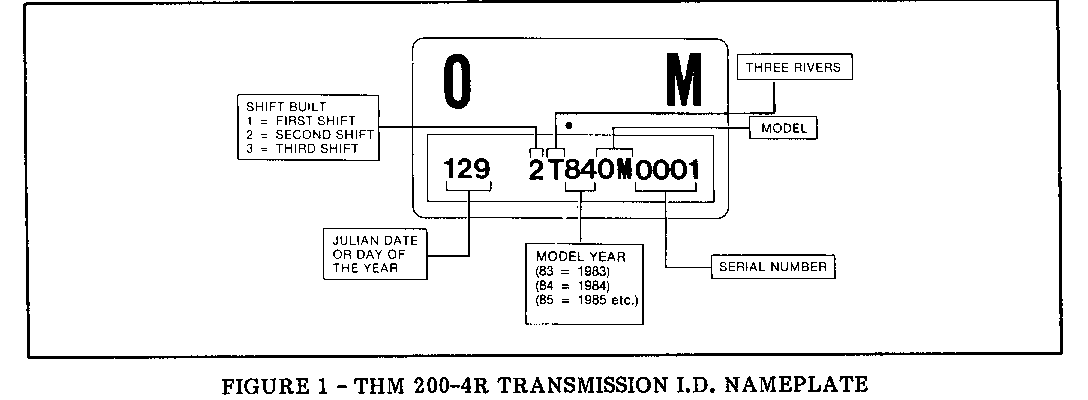HARSH 1-2 AND/0R 3-4 SHIFTS SOME MODEL THM 200-4R TRANS.

Some 1984 THM 200-4R transmissions may exhibit a harsh 1-2 and/or 3-4 shift. This harsh 1-2 and/or 3-4 shift may be caused by a damaged or mispositioned T.V. Boost valve spring.
Starting April, 1984, a new control valve assembly which has a new T.V. Boost valve spring went into production on all 1984 model THM 200-4R transmissions to correct his harsh 1-2 and/or 3-4 shift. (Refer to Chart 1 for part numbers and model applications, and Chart 2 for Julian date breakpoints when the new control valve assembly went into production.)
On transmissions built before the Julian dates in Chart 2, if a condition of harsh 1-2 and/or 3-4 shift is experienced and the cause is the damaged or mispositioned T.V. Boost valve spring, use the new control valve assembly.
The Julian date is shown on the nameplate (Figure 1). The nameplate is attached to the right rear side of the transmission case.
CHART 1
NEW CONTROL VALVE ASSEMBLY
MODEL AND PART NUMBER APPLICATIONS
MODELS CONTROL VALVE ASSEMBLY ------ PART NUMBERS ------------ AA AP 8639343 BQ 8639914 BT,BY 8639912 CH 8639393 CQ 8639400 CR 8639414 HE 8639424 HG 8639431 OF,OY 8639326 OG 8639452 OJ 8639462 OM 8639915 OZ 8639343
CHART 2
JULIAN DATE BREAKPOINTS WHEN NEW CONTROL VALVE ASSEMBLY WENT INTO PRODUCTION
MODELS JULIAN DATE ------ ----------- AA 116 BQ 109 BT 115 BY 121 CR 130 HE 125 HG 115 OG 110 OJ 114 OM 129
NOTE: Models not listed wi 11 have the new control valve spring assembly when they are produced.

General Motors bulletins are intended for use by professional technicians, not a "do-it-yourselfer". They are written to inform those technicians of conditions that may occur on some vehicles, or to provide information that could assist in the proper service of a vehicle. Properly trained technicians have the equipment, tools, safety instructions and know-how to do a job properly and safely. If a condition is described, do not assume that the bulletin applies to your vehicle, or that your vehicle will have that condition. See a General Motors dealer servicing your brand of General Motors vehicle for information on whether your vehicle may benefit from the information.
